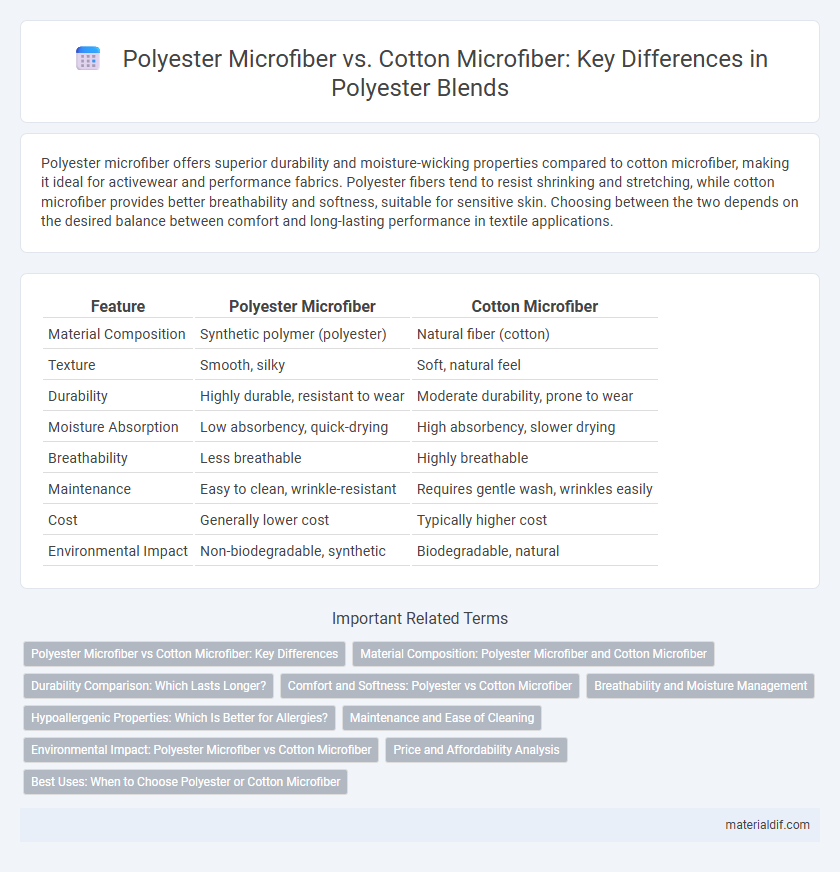Polyester microfiber offers superior durability and moisture-wicking properties compared to cotton microfiber, making it ideal for activewear and performance fabrics. Polyester fibers tend to resist shrinking and stretching, while cotton microfiber provides better breathability and softness, suitable for sensitive skin. Choosing between the two depends on the desired balance between comfort and long-lasting performance in textile applications.
Table of Comparison
| Feature | Polyester Microfiber | Cotton Microfiber |
|---|---|---|
| Material Composition | Synthetic polymer (polyester) | Natural fiber (cotton) |
| Texture | Smooth, silky | Soft, natural feel |
| Durability | Highly durable, resistant to wear | Moderate durability, prone to wear |
| Moisture Absorption | Low absorbency, quick-drying | High absorbency, slower drying |
| Breathability | Less breathable | Highly breathable |
| Maintenance | Easy to clean, wrinkle-resistant | Requires gentle wash, wrinkles easily |
| Cost | Generally lower cost | Typically higher cost |
| Environmental Impact | Non-biodegradable, synthetic | Biodegradable, natural |
Polyester Microfiber vs Cotton Microfiber: Key Differences
Polyester microfiber offers superior moisture-wicking and quick-drying properties compared to cotton microfiber, making it ideal for athletic wear and performance fabrics. Polyester fibers are more durable and resistant to shrinking, fading, and wrinkles, providing longer-lasting textiles than cotton microfibers. In contrast, cotton microfiber is more breathable and hypoallergenic, which appeals to those seeking natural fiber benefits in soft, comfortable clothing.
Material Composition: Polyester Microfiber and Cotton Microfiber
Polyester microfiber consists of ultra-fine synthetic fibers derived from polyethylene terephthalate (PET), offering durability, water resistance, and quick-drying properties. Cotton microfiber is made from natural cotton fibers that are finely woven to create softness and breathability, with enhanced moisture absorption due to cotton's natural fiber composition. The fundamental difference in material composition impacts performance, where polyester microfiber excels in strength and stain resistance while cotton microfiber provides superior comfort and natural fiber benefits.
Durability Comparison: Which Lasts Longer?
Polyester microfiber exhibits superior durability compared to cotton microfiber due to its resistance to wear, stretching, and shrinking. The synthetic fibers in polyester maintain structural integrity through repeated washing and heavy use, making it ideal for long-lasting textiles. Cotton microfiber, while softer and more breathable, tends to degrade faster under stress and frequent laundering.
Comfort and Softness: Polyester vs Cotton Microfiber
Polyester microfiber offers enhanced durability and moisture-wicking properties, providing a smooth and lightweight feel ideal for activewear and bedding. Cotton microfiber excels in natural breathability and softness, making it preferable for those seeking comfort with a plush texture. While polyester resists wrinkles and dries quickly, cotton's natural fibers promote superior airflow and hypoallergenic benefits.
Breathability and Moisture Management
Polyester microfiber excels in moisture management by wicking sweat away from the skin and drying rapidly, making it ideal for activewear and performance fabrics. Cotton microfiber offers superior breathability with a softer, more natural feel but tends to retain moisture, which can lead to longer drying times and reduced comfort during intense physical activity. Choosing between polyester and cotton microfibers depends on the balance between moisture control efficiency and breathable comfort requirements.
Hypoallergenic Properties: Which Is Better for Allergies?
Polyester microfiber exhibits superior hypoallergenic properties compared to cotton microfiber due to its synthetic fibers that resist dust mites and mold growth, common allergy triggers. Cotton microfiber, being a natural fiber, tends to retain moisture and harbor allergens more easily, increasing the risk of allergic reactions. For individuals with allergies or sensitive skin, polyester microfiber offers a more effective barrier against common allergens, enhancing overall comfort and health.
Maintenance and Ease of Cleaning
Polyester microfiber offers superior maintenance benefits compared to cotton microfiber, as its synthetic fibers resist stains and dry quickly, reducing washing time and effort. Cotton microfiber, although breathable and soft, tends to absorb more moisture and can retain dirt, requiring more frequent and intensive cleaning. The durability of polyester microfiber also means it withstands repeated washing without losing texture or color, making it a more practical choice for easy care.
Environmental Impact: Polyester Microfiber vs Cotton Microfiber
Polyester microfiber production relies heavily on petrochemicals, resulting in significant carbon emissions and non-biodegradable waste that contributes to long-term environmental pollution. Cotton microfiber, derived from natural fibers, requires extensive water usage, pesticides, and land resources, leading to soil degradation and water contamination in conventional farming systems. Comparing environmental impacts, polyester microfiber poses challenges with microplastic pollution, while cotton microfiber's sustainability depends on organic cultivation and water management practices.
Price and Affordability Analysis
Polyester microfiber is generally more affordable than cotton microfiber due to lower production costs and higher availability of raw materials. Cotton microfiber tends to be pricier because of the natural fibers involved and more intensive manufacturing processes. When considering price and affordability, polyester microfiber offers a cost-effective option for consumers seeking budget-friendly, durable fabric alternatives.
Best Uses: When to Choose Polyester or Cotton Microfiber
Polyester microfiber excels in moisture-wicking and durability, making it ideal for activewear, outdoor gear, and cleaning cloths requiring high absorbency and quick drying. Cotton microfiber offers superior softness and breathability, preferred for everyday clothing, bedding, and sensitive skin applications where comfort is paramount. Choosing between polyester and cotton microfiber depends on whether moisture management and resilience or natural softness and breathability are prioritized.
Polyester Microfiber vs Cotton Microfiber Infographic

 materialdif.com
materialdif.com